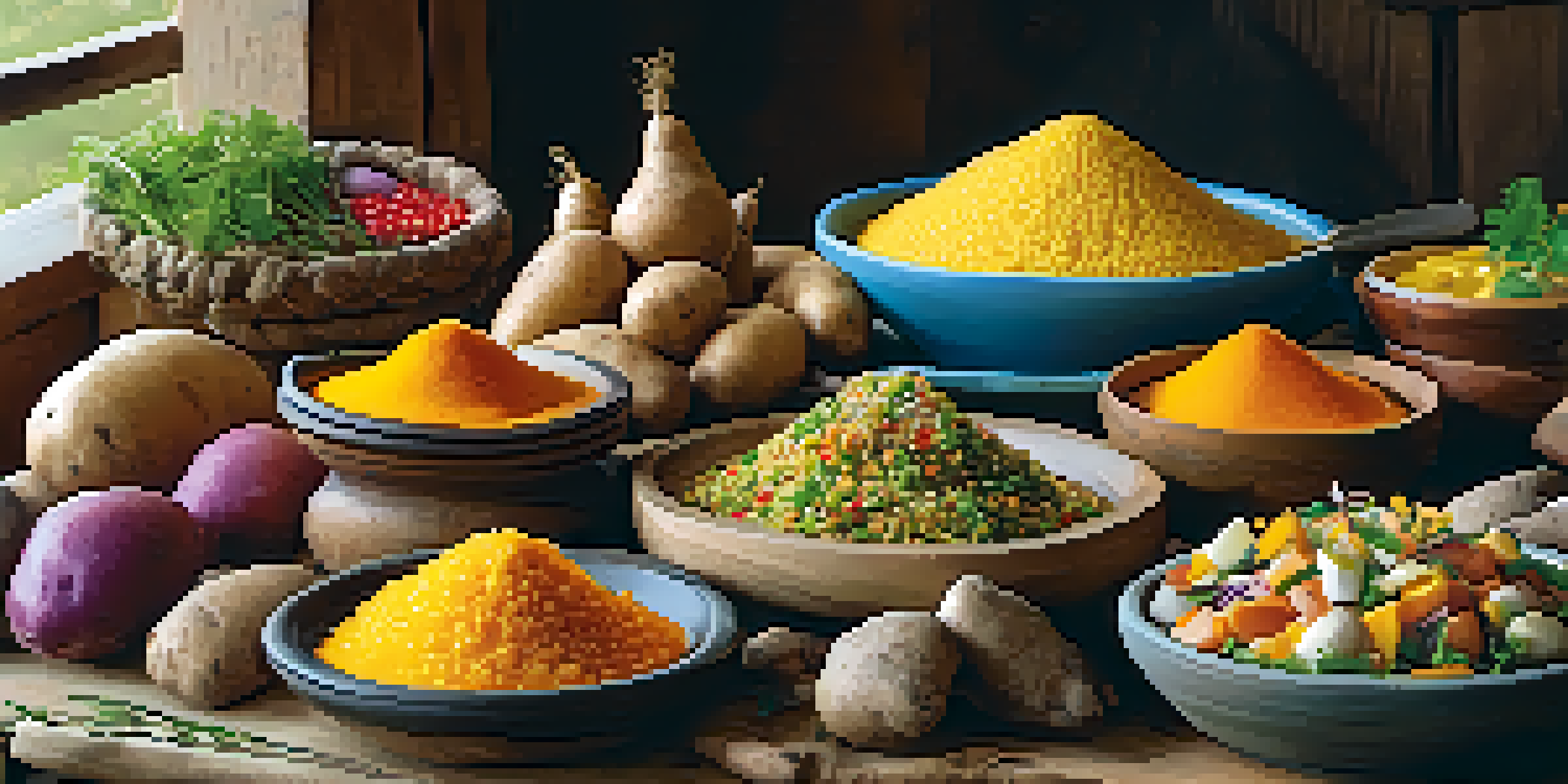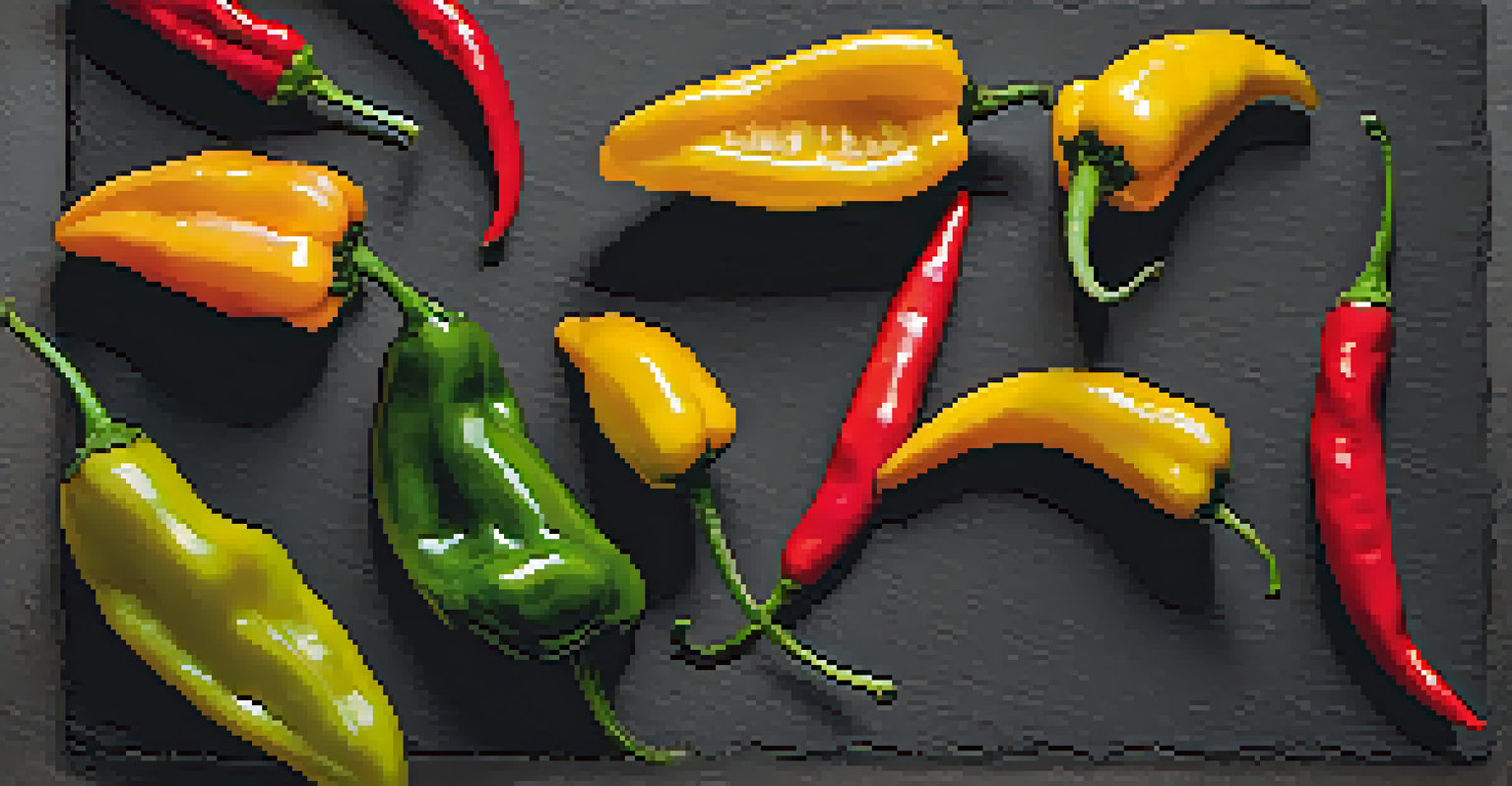Exploring Peruvian Ingredients in International Recipes

The Richness of Peruvian Cuisine: A Brief Overview
Peruvian cuisine is a vibrant tapestry woven from diverse cultural influences. With roots in Indigenous traditions, Spanish colonization, and Asian immigration, it creates a unique flavor profile that delights the senses. You can find staples like potatoes, corn, and quinoa, each telling a story of the land and its people. These ingredients not only add flavor but also nutrition, making them perfect for international recipes.
Food is a universal language that connects people across cultures.
One of the most fascinating aspects of Peruvian cuisine is its emphasis on fresh, local ingredients. The country boasts an incredible variety of potatoes—over 4,000 types! This biodiversity means that chefs can experiment with different textures and flavors, which can easily translate into global dishes. Imagine the creamy richness of a Peruvian potato in a classic French potato gratin.
As we explore further, we'll see how these traditional ingredients can enhance international recipes, bringing a unique twist to familiar dishes. From tangy aji peppers to fragrant herbs, the possibilities are endless.
Aji Amarillo: The Golden Pepper of Peru
Aji Amarillo is a staple in Peruvian kitchens, celebrated for its bright yellow color and fruity heat. This pepper can transform any dish with its unique flavor profile, adding a slight sweetness and a vibrant kick. Imagine incorporating Aji Amarillo into a classic Italian arrabbiata sauce—suddenly, your pasta dish has a warm, golden glow and a new depth of flavor.

Beyond its taste, Aji Amarillo is packed with nutrients, including vitamins A and C. It’s not just about flavor; it’s about health too! By swapping out regular chili peppers for Aji Amarillo, you can create healthier, more flavorful versions of your favorite dishes. Think of it as a flavorful bridge between cultures.
Peruvian Cuisine's Unique Ingredients
Peruvian cuisine showcases a rich array of ingredients, such as potatoes and quinoa, which enhance both local and international dishes.
Whether you're mixing it into marinades, soups, or even salad dressings, Aji Amarillo opens up a world of culinary creativity. It’s a fantastic reminder that cooking is about exploration and joy, blending the familiar with the exotic.
Quinoa: The Ancient Grain with Modern Appeal
Quinoa, often hailed as a superfood, has its roots deep in the Andes of Peru. This ancient grain has gained international popularity for its high protein content and gluten-free nature, making it a favorite for health-conscious eaters. Imagine swapping rice for quinoa in a stir-fry; not only do you get a nutritional boost, but the nutty flavor complements the dish beautifully.
Cooking is like love; it should be entered into with abandon or not at all.
Its versatility allows quinoa to shine in both savory and sweet dishes. You can use it in breakfast bowls, salads, or even baked goods, providing a unique twist that’s both nutritious and satisfying. This adaptability means that quinoa is a perfect ingredient for experimenting with international flavors, from Mediterranean to Asian cuisines.
By incorporating quinoa into your meals, you’re not just enjoying a delicious dish; you’re also embracing a piece of Peruvian heritage. It’s a simple way to celebrate global culinary traditions while nourishing your body.
Cilantro: A Fresh Herb with Global Appeal
Cilantro, known as coriander in some parts of the world, is a beloved herb in Peruvian cooking. Its fresh, citrusy flavor brightens up dishes, making it a staple in salsas, sauces, and salads. Imagine adding a handful of chopped cilantro to a classic Mexican guacamole; it brings a refreshing twist that elevates the entire dish.
This herb is not only flavorful but also packed with antioxidants and vitamins. It’s a fantastic way to add freshness and complexity to international recipes, whether you’re using it in a Thai curry or a Mediterranean tabbouleh. Cilantro serves as a reminder that simple ingredients can make a big impact.
Aji Amarillo Adds Flavor and Health
Aji Amarillo, with its fruity heat and nutritional benefits, brings a vibrant twist to various recipes, making it a versatile ingredient.
Plus, cilantro’s aromatic qualities make it a perfect garnish, adding both beauty and flavor to your dishes. As we explore international recipes, don’t forget the power of this humble herb—it can truly transform your meals.
Potatoes: Peru's Gift to Global Cuisine
Did you know that Peru is the birthplace of the potato? With thousands of varieties, potatoes are a cornerstone of Peruvian cuisine and can be used in countless ways. Imagine using a purple Peruvian potato to make vibrant potato salad; it’s not only visually stunning but also adds a unique flavor to the dish.
Potatoes can serve as a wonderful base for international recipes, from creamy mashed potatoes in American comfort food to crispy patatas bravas in Spanish tapas. Their versatility makes them an ideal ingredient for experimentation, allowing for various textures and flavors to shine.
By incorporating Peruvian potatoes into your cooking, you’re not just enhancing the taste but also celebrating the history of a beloved ingredient. This simple tuber can connect your table to the rich heritage of Peru, making every meal a cultural experience.
Lucuma: The Sweet Fruit of the Andes
Lucuma, often referred to as the 'Gold of the Incas,' is a unique fruit that adds a sweet, maple-like flavor to desserts. This nutrient-dense fruit is not only delicious but also rich in vitamins and antioxidants. Imagine using lucuma powder in a smoothie or ice cream; it adds a natural sweetness without the guilt of refined sugars.
Its distinct flavor makes lucuma an excellent ingredient for international desserts. You can blend it into a rich chocolate mousse or incorporate it into an Asian-style coconut pudding, creating a fusion of flavors that delights the palate. It’s a sweet way to explore global cuisine while enjoying a taste of Peru.
Culinary Fusion with Peruvian Flavors
Incorporating Peruvian ingredients like lucuma and pisco into global recipes encourages creativity and celebrates cultural exchange.
By bringing lucuma into your kitchen, you’re embracing a piece of Peruvian culture that encourages creativity and innovation in dessert-making. This unique fruit is a delicious reminder that exploring ingredients can lead to delightful surprises.
Pisco: The Spirit of Peru in Cocktails
Pisco, Peru’s national spirit, is a brandy made from fermented grapes that has a rich history and distinct flavor. This versatile spirit can enhance cocktails, providing a unique twist to classic drinks. Imagine substituting vodka with pisco in a cosmopolitan; the result is a refreshing cocktail with a hint of the Andes.
Pisco is not only about taste but also about experience. It’s often enjoyed in traditional drinks like the Pisco Sour, which blends the spirit with lime juice, simple syrup, and egg white for a frothy finish. Incorporating pisco into your cocktail repertoire is an adventurous way to celebrate Peruvian culture while impressing your guests.

Using pisco in international cocktails opens up a world of possibilities, from fruity mixes to sophisticated sips. It encourages creativity, inviting mixologists and home bartenders alike to experiment with flavors and combinations that pay homage to this iconic Peruvian spirit.
Bringing It All Together: A Culinary Adventure
Exploring Peruvian ingredients in international recipes is more than just a cooking experiment; it's a culinary adventure. Each ingredient carries its own story, weaving together the rich tapestry of Peru's history and culture. By incorporating these elements into your cooking, you’re not only enhancing your dishes but also experiencing the joy of cultural exchange.
As you experiment with ingredients like Aji Amarillo, quinoa, and lucuma, remember that cooking is about creativity and personal expression. Don't be afraid to mix and match, creating a delightful fusion of flavors that reflects your tastes and the vibrant heritage of Peru.
Ultimately, this exploration invites you to think outside the box and embrace the diversity of flavors that global cuisines offer. So roll up your sleeves, get cooking, and embark on a delicious journey that celebrates the best of both worlds—Peru and international cuisine!